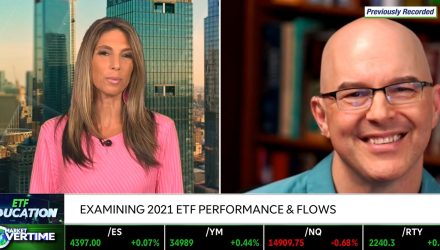Dave Nadig, CIO and Director of Research at ETF Trends, recently appeared on Market Overtime to discuss record ETF inflows and how that money is being allocated by investors in current markets.
Nadig opened by discussing China and the recent regulatory crackdowns on internet companies and education companies. “China ETFs have been a real success story in terms of flows until the last few days,” Nadig explained. Inflows into China ETFs have seen roughly $7.5 billion for the year so far.
Regulations have hit ETFs focused in the Chinese internet sector hard; The KraneShares CSI China Internet ETF (KWEB) is a prime example of exactly how much these markets have suffered in the last few days. KWEB is currently down almost 50% from its all-time highs in February, but inflows have been pouring in with the price reduction.
“We have seen nothing but inflows. So investors, while they’re seeing this bad performance recently, are actually really reallocating on the dip,” Nadig said. He explained that each day had seen hundreds of millions of dollars of inflows into the fund.
Stepping back to take a broader look at the markets and overall inflows, Nadig believes that the record $510 billion inflows into ETFs is primarily centered around long allocations. While some investors allocate their money to the more short-term, headline-grabbing kind of thematic ETFs like ARK Invest’s ARK Innovation ETF (ARKK) that experience greater volatility, most of it is going into lower volatility ETFs.
Watch Dave Nadig On TD Ameritrade
“Most of (the $500 billion) is going into pretty traditional, low cost, index products: the S&P 500, 20 Year Treasuries, global bond funds, global equity funds, pretty straightforward allocations,” Nadig explained. This reflects a dedication to the long haul on the part of advisors and investors in Nadig’s mind.
While equity markets have seen huge flows, Nadig views this as money that is “very sticky” as it has no other place to go. For now, most investors seem to be holding onto their stocks, much as people are holding onto cash currently.
With inflation so heavily on everyone’s minds when it comes to the markets and investing, the biggest issue for long term investors is that inflation “erodes your buying power,” Nadig said. Most investors are saving for the long term, and as inflation raises the cost of things, it makes it difficult for investors to afford things when they are ready to withdraw that money.
“Most investors are looking at bonds and saying they just don’t think that’s going to happen. That’s part of why we see so much allocation into equities, because that risk premium you get for being in equities turns out to pay off on the long run.”
Money inflows have picked up into ETFs that claim to beat inflation, with heavier investing seen in commodities. Many people believe it to be the beginning of the next “commodities super-cycle with increased inflows.”
Investors looking for a great ETF in the space should look to Invesco’s Optimum Yield Diversified Commodity Strategy No K-1 ETF (PDBC) which offers broad exposure to commodity futures without the hassle of a K-1 for tax purposes.
The best call for investing in current market environments is diversification, Nadig said. For investors that are concerned about where the markets go from the all-time highs that they’re currently experiencing, an ETF such as the JPMorgan Equity Premium Income ETF (JEPI), which carries lower risk and is actively managed, is a great play when paired with [???call rating? 6:24] for income generation.
Overall, ETFs are a great fit for any investor, particularly when it comes to reducing taxes. “ETFs have been a great low-cost tool to manage those portfolio allocations while minimizing your taxes,” Nadig said.
For more market trends, visit ETF Trends.
